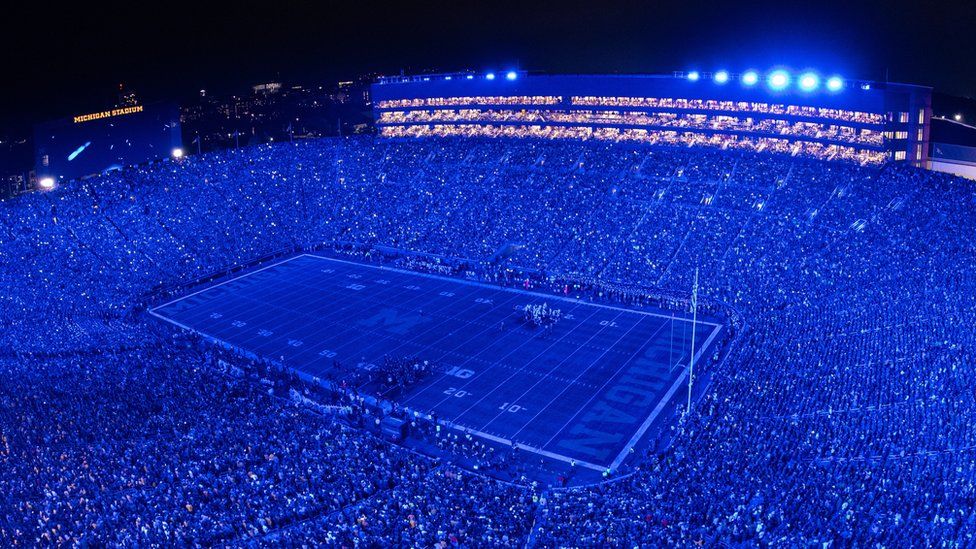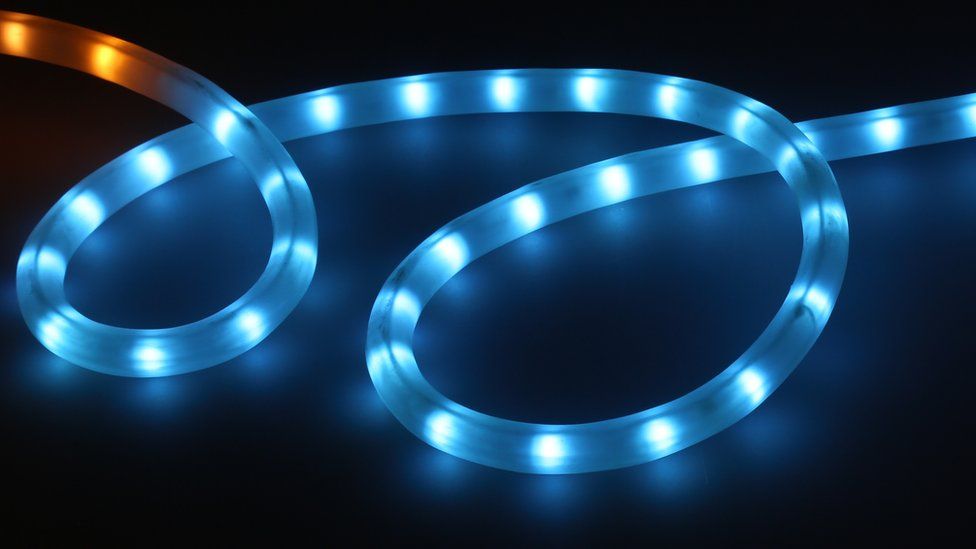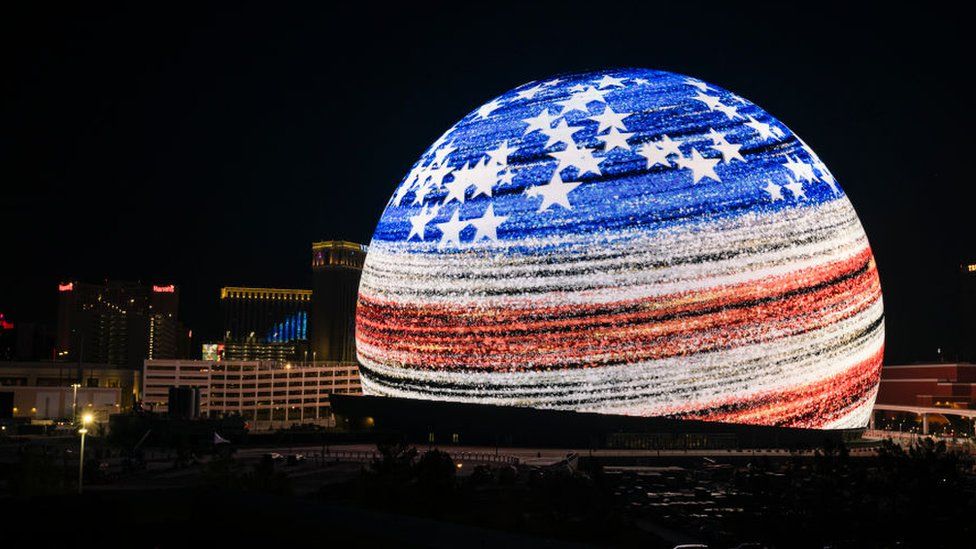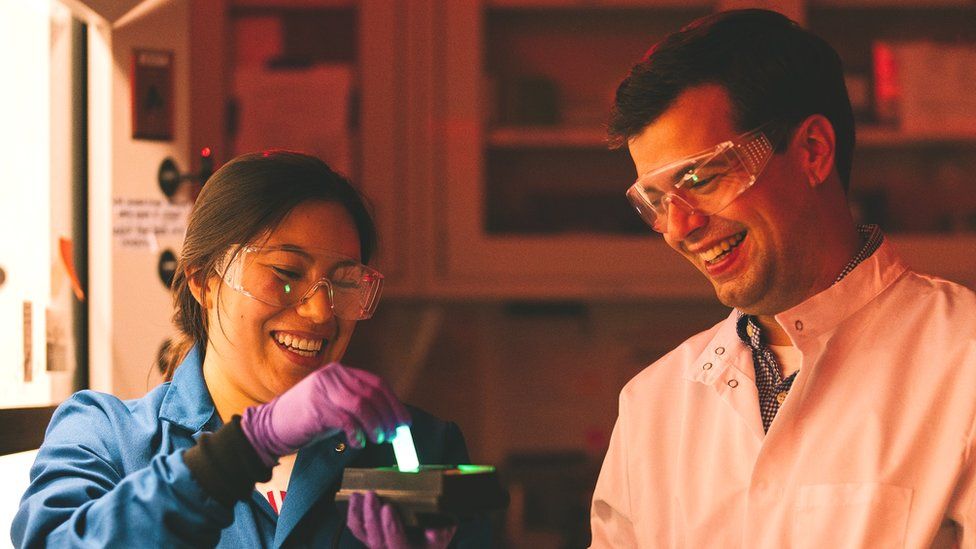The incredible power of blue LEDs

The largest stadium in the US, filled with tens of thousands of noisy American Football fans, was drenched in blue light. People in the stands held their phones up, creating a sea of star-like speckles in the crowd.
“This is our team! This is Michigan!” blared a video on the giant screen as cheers erupted.
The atmosphere was heightened by a new visual entertainment system, which debuted at Michigan Stadium on 16 September. Coloured sequences of flashing, sweeping lights celebrate touchdowns or accompany music.
The University of Michigan team’s colours are yellow, or “maize”, and blue. The light show was designed to match.
“It 100% has an impact on the experience within the stadium,” says Jake Stocker, director of game presentation and fan experience at the University of Michigan.
“One more exciting element of coming to a football game that you’re not getting sitting at home on your couch.”
As in many stadiums, light-emitting diodes (LEDs) provide the light show at Michigan Stadium.

But not very long ago, blue LEDs powerful enough to illuminate such a large stadium – the third-largest in the world – would have seemed outrageously advanced. Bright LEDs that emit blue light were only invented in the 1990s. The scientists who came up with the technology later received a Nobel Prize.
Researchers say LEDs could be even cheaper and more energy efficient than they are today. They could revolutionise everything from outdoor lighting to virtual reality headsets.
At Michigan Stadium, the various colours on show are produced by entertainment lighting systems with red (R), green (G) and blue-emitting (B) LED units or luminaires, says Brad Schlesselman, senior research engineer at Musco Lighting, which supplied the technology. RGB systems can actually emit a huge range of colours just by mixing red, green and blue at varying intensities.
“It’s getting down to even the high school level where there’s a demand for the colour-changing and theatrical stuff that we’re seeing in Michigan,” adds Mr Schlesselman.
Plus, towns and cities in the US are fitting LED lighting to local landmarks, including water towers, in order to light up the structures in special colours for certain events or occasions. Pink for breast cancer awareness month, for example, which is this month, October.
Perhaps the most spectacular use of LEDs is at the Las Vegas Sphere which opened last month. Millions of LEDs can transform the exterior into almost any pattern or image you can imagine, and light up enormous screens inside.

In the 1970s and 80s, though, LEDs were routinely dismissed as ineffective. “There’s no way that this little dinky toy light is going to do anything useful – that was the attitude at the time,” says Paul Scheidt, senior product marketing manager at Cree LED, a major manufacturer of the devices. These expensive and weakly emitting light sources were fine for a tiny red indicator light or an infrared TV remote, maybe, but little else.
That changed when engineers were able to produce LEDs that emitted far more photons, or light, than before. LEDs beam out light when electrons – negatively charged particles – within the device drop from a higher energy state to a lower one. This process releases energy in the form of light. By using different materials, you can adjust the size of the drop (known as the bandgap) and the wavelength, or colour, of the light emitted.
Blue was particularly tricky because the key material required for that hue, gallium nitride, was difficult to manufacture without defects. But blue is a powerful, very high energy colour (with a large bandgap) so blue LEDs can be used as the basis for all other colours in some RGB OLED TV displays, for example – the red and green hues would just be illuminated, originally, by blue LEDs.
Blue LEDs are also typically the source for white lights. The blue light is just adjusted using materials called phosphors.
And yet completely new LED technology is waiting in the wings because scientists say this technology could be even more efficient.

Dan Congreve and colleagues at Stanford University are working on LEDs made with perovskite crystals, a material often used in solar cells. Perovskites are cheap and easy to make. They are “tuneable”, says Dr Congreve, to your desired colour and could even be mixed into a solution and then painted onto surfaces as light-emitting layers.
Getting perovskite LEDs to remain stable is hard, though. They keep breaking.
“We turn them up and we measure them, they’re dead pretty quickly,” says Mr Congreve. He adds that he hopes this problem will be surmountable. He and his colleagues have already improved the stability since their first experiments.
If they can overcome such issues, perovskite LEDs could be utilised across a wide variety of devices says John Buckeridge a materials physicist at University College London.
Separately, in Japan, researchers recently came up with a blue LED that can be powered using a single AA battery supplying just 1.47 volts. Usually, you’d need 4 volts minimum. “That’s cool, as an engineering feat,” says Dr Congreve, who was not involved in the work himself.
The system uses clever physics to boost the production of photons. In a traditional LED, when power is applied, the internal materials achieve states of excitement that, three quarters of the time, don’t actually emit light. The team in Japan was able to encourage these excited states to combine and produce light, while requiring less energy to begin with. They published their work in a paper in September.


For technologies such as virtual reality and augmented reality, we need extremely bright LEDs to see the images clearly, says Keith Strickland, chief executive officer at Plessey Semiconductors, a British firm working with Meta on such devices.
But current OLED displays aren’t bright enough so the company is developing micro LEDs, individual LEDs in red, green or blue, that are significantly smaller than 20 microns in size – that’s less than a third of the thickness of a human hair.
At this microscopic scale, it’s actually the colour red that is most challenging, says Dr Strickland. Red micro LEDs suffer more from inefficiencies at the edge of the light-producing component. Since the device is so small, its edge has an exaggerated impact, making these problems more noticeable.
LEDs are fast becoming ubiquitous but their technological development is far from complete. As Dr Congreve says, “There’s still room to grow” – and glow, presumably.
